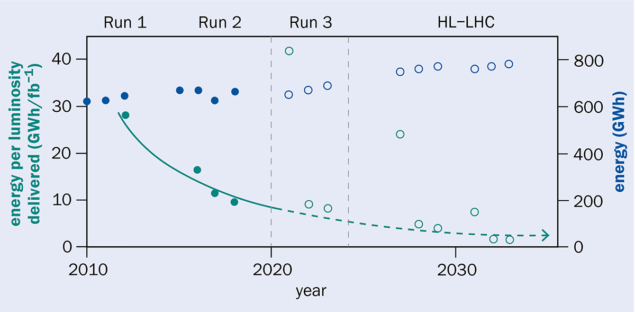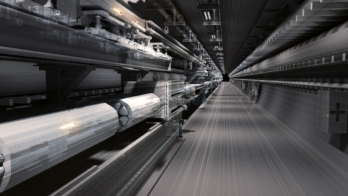For the LHC and future facilities, it is vital that each MWh of energy consumed brings demonstrable value to CERN’s scientific output, says Serge Claudet.

The famous “Livingston diagram”, first presented by cyclotron co-inventor Milton Stanley Livingston in 1954, depicts the rise in energy of particle accelerators as a function of time. To assess current and future facilities, however, we need complementary metrics suited to the 21st century. As the 2020 update of the European strategy for particle physics demonstrated, such metrics exist: instead of weighing up colliders solely on the basis of collision energy, they consider the capital cost or energy consumption with respect to the luminosity produced.
Applying these metrics to the LHC shows that the energy used during the upcoming Run 3 will be around three times lower than it was during Run 1 for similar luminosity performance (see “Greener physics” figure). The High-Luminosity LHC (HL-LHC) will operate with even greater efficiency. In fact, CERN accelerators have drawn a similar power for a period of 40 years despite their vastly increased scientific output: from 1 TWh for LEP2 to 1.2 TWh for the LHC and possibly 1.4 TWh at the HL-LHC.
The GWh/fb–1 metric has now been adopted by CERN as a key performance indicator (KPI) for the LHC, as set out in CERN’s second environmental report published last year. It has also been used to weigh up the performance of various Higgs factories. In 2020, for example, studies showed that an electron–positron Future Circular Collider is the most energy efficient of all proposed Higgs factories in the energy range of interest. But this KPI is only part of a larger energy-management effort in which the whole community has an increasingly important role to play.
In 2011, with the aim to share best practices amongst scientific facilities, CERN was at the origin of the Energy for Sustainable Science at Research Infrastructures workshop series. A few years later, prompted by the need for CERN to move from protected-tariff to market-based electricity contracts, the CERN energy management panel was created to establish solid forecasts and robust monitoring tools. Each year since 2017, we send virtual “electricity bills” to all group leaders, department heads and directors, which has contributed to a change of culture in the way CERN views energy management.
Best practice
Along with the market-based energy contract, energy suppliers have a duty by law (with tax-incentive mechanisms) to help their clients consume less. A review of energy consumption and upgrades conducted between CERN and its electricity supplier EDF in 2017 highlighted best practices for operation and refurbishment, leading to the launch of the LHC-P8 (LHCb) heat-recovery project for the new city area of Ferney-Voltaire. Similar actions were proposed for LHC-P1 (ATLAS) to boost the heating plant at CERN’s Meyrin site, and heat recovery has been considered as a design and adjudication parameter for the new Prevessin Computer Centre. Besides an attractive 5–10 year payback time, such programmes make an important contribution to reducing CERN’s carbon footprint.

Energy efficiency and savings are an increasingly important element in each CERN accelerator infrastructure. Completed during Long Shutdown 2, the East Area renovation project led to an extraordinary 90% reduction in energy consumption, while the LHC Injectors Upgrade project also offered an opportunity to improve the injectors’ environmental credentials. Energy economy was also the primary motivation for CERN to adopt new regenerative power converters for its transfer lines. These efforts build on energy savings of up to 100 GWh/y since 2010, for example by introducing free cooling and air-flow optimisation in the CERN Computer Centre, and operating the SPS and the LHC cryogenics with the minimum of necessary machines. CERN buildings are also aligning with energy- efficiency standards, with the renovation of up to two buildings per year planned over the next 10 years.
There will be no future large-scale science projects without major energy-efficiency and recovery objectives
This year, a dedicated team at CERN is being put together concerning alignment with the ISO50001 energy-management standard, which could bring significant subsidies. A preliminary evaluation was conducted in November 2021, demonstrating that 54% of ISO expectations is already in place and a further 15% is easily within reach.
The mantra of CERN’s energy-management panel is “less, better, recover”. We also have to add “credible” to this list, as there will be no future large-scale science projects without major energy-efficiency and recovery objectives. Today and in the future, we must therefore all work to ensure that every MWh of energy consumed brings demonstrable scientific advances.





